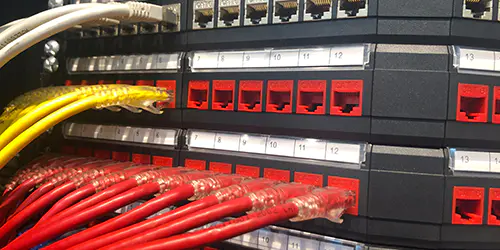Patch panel is one of the indispensable products for computer room cabling, and is the most important component in the management subsystem. It is the hub for achieving cross connection between the vertical trunk and horizontal cabling subsystems. Common Patch panel can be divided into two types: network patch panel and language patch panel. Today, we will explain the difference between integrated patch panel and modular type patch panel in network patch panels.
Network patch panel can be further divided into shielded and unshielded types, integrated and modular. Linkbasic network patch panel is a 24 port network patch panel, with a length of 19 inches and a height of 1U. The end interface shell material is made of high-strength PC material, and the front end is mainly composed of RJ45 sockets and identification area. The identification area is composed of paper identification paper and PE plastic transparent partition. The RJ45 interface is used to terminate network patch cords, with eight "golden needles" arranged in the holes. The overall structure of the network patch panel is made of high-quality cold-rolled steel plate material, with a cable manager on the back, which can effectively guide the cables to the end points.
Frequent plugging and unplugging of patch cords during use can cause certain losses to the "gold pins" inside the network distribution frame, such as deformation and breakage of the "gold pins". In order to meet higher usage requirements, wear-resistant materials will be used to coat the "gold needle", which plays a wear-resistant role. Therefore, during the production of distribution frames, gold will be used to electroplating the "gold needle". After electroplating, the information jack can meet the industry standard of 750 plug and pull tests.
01Integrated patch panel

The 24 RJ45 sockets of the integrated patch panel are encapsulated in the skeleton and connected as a whole. Its back structure consists of 4 sets of IDC wiring posts, each of which corresponds to 6 RJ45 modules and shares a common circuit board. The main advantage of this patch panel design is its simplicity and convenience, reducing installation and operating costs.
However, its drawbacks are also very obvious. Due to the integrated patch panel being an integrated package and the fact that six RJ45 jacks share the same circuit board, it is difficult to replace one RJ45 port on site if there is a problem, and it can only be replaced at the factory or abandoned, which is very inconvenient. Therefore, integrated patch panel cannot reduce the use of ports according to their actual needs.
02Modular type patch panel

In order to solve the problems of integrated patch panels, some modifications have been made on the original basis. Modular type patch panel is composed of a 24 port empty patch panel and 24 RJ45 information modules, which can be independently installed on the empty patch panel. The advantage is that each socket of the patch panel uses an independent circuit board, and the interference between information modules is minimal.
In addition, if there is wear on the socket during use, simply disassemble the worn module for replacement, which is time-saving and convenient. Therefore, modular type patch panel are more flexible and compatible than integrated patch panel, reducing unnecessary waste during cabling.
Linkbasic patch panel jack can withstand up to 1500 times of plugging and unplugging, far exceeding the industry standard of 750 times, and has passed the Cat6 unshielded channel inspection report, Cat6 unshielded permanent link inspection, REACH, and RoHS certification.
After reading this introduction, I believe everyone should have a clearer understanding of how to make a purchase!








 English
English 简体中文
简体中文


